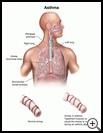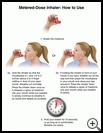
Asthma
________________________________________________________________________
KEY POINTS
- Asthma is a chronic lung disease that causes coughing, wheezing, and shortness of breath.
- Asthma is treated with several kinds of medicine.
- Learn what can trigger your symptoms and how to manage them. Work with your healthcare provider to develop a written asthma action plan to help you recognize and handle problems and know when you need to see your provider.
________________________________________________________________________
What is asthma?
Asthma is a long-lasting (chronic) lung disease. It causes coughing, wheezing, and shortness of breath.
Asthma may be mild, moderate, or severe. An asthma attack may last a few minutes or a few days. Attacks can happen anywhere and at any time. Severe asthma attacks can be life threatening. It is very important to get prompt treatment for asthma attacks and to learn to manage your asthma so you can live a healthy, active life.
Asthma is a long-lasting condition, even though you might not have any symptoms every day or even every year. It is more common in children than adults. People who had asthma as children often have no symptoms once they become adults. However, the symptoms may come back later in life. Asthma that develops for the first time in mid- or late life usually keeps being a problem for the rest of your life.
You may find that there are things you used to do that you can no longer do because it is harder to breathe.
Many Americans have asthma, and the number of people who have asthma is increasing worldwide.
What is the cause?
Asthma symptoms are caused by two different problems in the airways.
- One problem is that the muscles in the airways tighten up, which causes chest tightness and wheezing.
- The other problem is swelling, irritation, and too much mucus in the airways.
If you have asthma, symptoms often start after you are exposed to a trigger. Asthma triggers can include:
- Exercise
- Allergies, such as dust, pollen, mold, or animal fur
- Something that irritates your lungs, such as cold air, smoke, or strong smells like paint or perfume
- Medicines like aspirin or NSAIDs
- An infection such as a cold, the flu, or a sinus infection
- Strong emotions or stress
- Indigestion, also called gastroesophageal reflux disease, or GERD. If you often have problems with acid indigestion you may have more asthma symptoms, especially during sleep.
Some of the factors that may increase the risk that you will have asthma are:
- Low birth weight
- Having 1 or more close family members who have asthma
- Exposure to secondhand smoke or a lot of environmental pollutants (for example, smog in a large city)
- On-the-job exposure to chemicals, such as chemicals used in the manufacturing industry, farming, and hairdressing
- Obesity
What are the symptoms?
Symptoms can be occasional, daily, or only during sleep, and include:
- Wheezing (a high-pitched whistling sound when you breathe in or out)
- Coughing
- Shortness of breath, or feeling like you cannot get enough air
- Chest tightness
A single attack of wheezing does not mean you have asthma. Some infections and chemicals can cause wheezing that lasts for a brief time or a few days and then does not happen again.
How is it diagnosed?
Your healthcare provider will ask about your history of breathing problems. You will have a physical exam. You may have breathing tests called pulmonary function tests or spirometry. You may be tested before and after taking medicine to see how your symptoms respond to medicine.
How is it treated?
The goal of treatment is to allow you to live a normal, active life. With proper treatment, your asthma should be less of a problem day to day. It will also be less likely that you will have a serious asthma attack or more problems in the future. Treatment will probably include prescribed medicines. You may also need to avoid allergy-causing substances or irritants.
Medicines
You may need one or more of these medicines to control asthma:
- Quick-relief medicines, also called reliever, or rescue medicines, are short-acting bronchodilators. These medicines are used as needed to treat asthma attacks. They are not used on a regular, daily basis to prevent asthma symptoms. Rescue medicines work fast to relax the muscles of your airways and keep the muscles from getting too tight. You should learn to recognize the symptoms of an asthma attack and take these medicines as soon as symptoms start. To prevent asthma attacks, you may need a different type of medicine called a controller.
- Controller medicines help prevent asthma attacks and control your symptoms. You will take these medicines every day, even if you are not having symptoms. They do not provide quick relief of wheezing in acute asthma attacks. There are several kinds of controller medicines for asthma:
- Long-acting bronchodilators relax the muscles of your airways and keep your muscles from getting too tight. When your airway muscles are more relaxed and less tight, you have fewer symptoms and will be able to breathe better.
- Inhaled steroids are similar to hormones made by your body. They block some of the chemicals that cause irritation and swelling in your body. By lessening the swelling, you are able to breathe better. Inhaled steroids mainly affect your lungs.
- Oral steroids can be taken as pills, chewable tablets, or syrup. They may be taken for several days to treat asthma symptoms. Oral steroids reduce inflammation all through your body. Because of this, if you take them for a long time, you may have side effects. Make sure you know how and when to take your medicine. Do not take more or less than you are supposed to take.
- Leukotriene modifiers are another type of long-term control medicine that comes in the form of pills that you take every day. They are often taken along with other long-term control medicines for asthma.
- Biologic targeted therapy, by IV or shot every two weeks or once a month, can help patients with refractory allergic asthma.
You need to work with your healthcare provider to find the right treatment for you. Make sure you understand how to use each of your medicines. Some inhalers are quick acting and meant to be used when you have an asthma attack. Other inhalers are slow acting and help prevent attacks, but they do not help when you are having an attack. Ask your healthcare provider about using a spacer.
In addition to medicines, your healthcare provider may prescribe a peak flow meter to measure how well air is moving out of your lungs. A peak flow meter is a small, hand-held device that shows how well air moves out of your lungs. You blow into the device and it gives you a score, or peak flow number. Your score shows how well your lungs are working at the time of the test. Your healthcare provider will tell you how and when to use your peak flow meter. He or she also will teach you how to take your medicines based on your score.
If you are pregnant, talk to your healthcare provider about changes you may need to make.
How can I take care of myself?
Learn about asthma and its treatment.
- Learn to recognize signs and symptoms of an asthma attack. Many people with asthma either don't recognize their asthma symptoms or don’t realize how quickly their symptoms can get serious. Pay attention to your symptoms and, if your healthcare provider recommends it, check your breathing with a peak flow meter. Ask at what peak flow reading you should call your provider.
- Work with your healthcare provider to develop a written asthma action plan. Following the plan will help you manage your asthma every day. It will help you recognize and handle asthma problems and know when you need to see your provider.
- Make sure you know how to use your inhalers correctly. Take your medicines exactly as prescribed. Always have your quick-relief medicine on hand and available. If you are taking a long-term control medicine, be sure to take it every day, just as your provider tells you. This prevents asthma attacks. If you are wheezing even though you are using your controller medicine, let your provider know. Don’t just stop the medicine. If you are using both quick-relief and long-term control inhalers at the same time, use the quick relief inhaler first. Then wait several minutes before using the control inhaler.
- Learn what things can trigger your symptoms and how to manage them. For example, you may need to cover your mattress, box springs, and pillows with zippered plastic covers. It may help to stay indoors when the humidity or pollen count is high. Avoid cigarette smoke.
You should also:
- See your healthcare provider for regular checkups as often as recommended.
- Ask your provider if it’s OK for you to take aspirin. Some people with asthma are allergic to aspirin and it causes them to wheeze. Aspirin is more likely to cause problems than other anti-inflammatory medicines, such as ibuprofen or naproxen, but sometimes these medicines can also cause wheezing. Acetaminophen does not cause wheezing.
- Get the flu vaccine every year in October or November at the start of flu season.
- Ask your healthcare provider if you should get the pneumococcal vaccine if your asthma is severe and you need to use controller medicine.
Asthma can be a life-threatening condition.
- If your medicines are not keeping you breathing comfortably, contact your healthcare provider.
- If you are having side effects from your asthma medicines, let your healthcare provider know.
- If you are having an asthma attack and you keep having symptoms after using your quick-relief inhaler, you must get medical care right away. This may mean going to the emergency room or calling 911.
In most cases, asthma is a controllable disease and you can live an active life. But it requires understanding your medicines, using them as directed, and working with your healthcare provider to find the best treatment plan for you. This plan may change as you get older, move to a different location, or start having other health problems.
You can get more information from:
- American College of Allergy, Asthma and Immunology
847-427-1200
http://acaai.org/ - American Lung Association
800-586-4872
http://www.lung.org/ - Asthma and Allergy Foundation of America (AAFA)
800-727-8462
http://www.aafa.org



